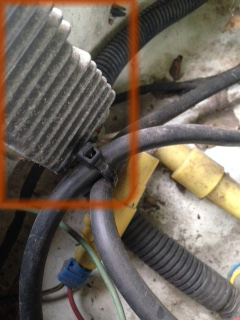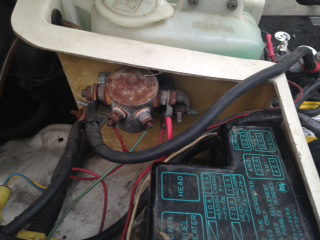
dolcecanto
-
Posts
10 -
Joined
-
Last visited
Content Type
Events
Profiles
Forums
Gallery
Posts posted by dolcecanto
-
-
-
3 minutes ago, jdemaris said:
It looks to me like the cranking battery and "house" battery are both joined on one post, while the white 10 gauge wire (approx) that comes from the alternator is on the other post. That is absolutely wrong. Wired that way, neither battery gets any charge unless the isolator-relay is energized and when not- alternator charge current has nowhere to go and might fry the alternator. Just a guess since I cannot see much with the photos.
Thank you, this is information I will give mechanic tomorrow.
-
1 hour ago, Maineah said:
If it is a relay type (like your picture) yes the alternator is wired directly to the starting battery. There seems to be an issue with your picture though it appears to have two battery cables connected to the same terminal that is not correct that defeats the purpose of the isolator.
Thank you. I will copy your posts for the mechanic tomorrow.
-
On May 1, 2016 at 9:20 AM, jdemaris said:
If the lights in the dash worked and did not go dim when you turned the key to "crank" - then battery power (from the main battery) is not the problem. If battery power is low, and starter in good shape. the lights should go dim when it fails to turn over. The way your isolator is bypassed right now - plugging in your converter/charger to shore-power would charge both batteries. Now - if are are saying that charging the batteries makes it start okay, but when sitting for awhile and NOT on a charger it does NOT start - then I'm a little stumped. Need to take some simple voltage readings. Battery (cranking) should be near 13 volts when not being used and should drop to 9-10 volts when the starter is cranking properly.
On the sun reader wiring diagram published it shows the isolator/solenoid connected to the alternator. The shop had wired the alternator directly to the starting battery. Is this incorrect? Apologies for electrical wiring ignorance.
-
1 hour ago, jdemaris said:
As I recall, when the the charge and brake light comes on - a bad alternator is a common cause but NOT the only possible cause. I think with an 87, a bad fuse, bad fusible link, bad connection, or bad charge relay can also cause the problem. Not fresh on my mind though and I'm not in the mood to study a 1987 schematic. Best thing is to check the alternator first and if it checks OK - obviously there are more things to check.
Thank you to both Linda and you. Very helpful. The mechanic who put on the alternator has a shop only 4 blocks away. I will call him tomorrow.
-
1 hour ago, jdemaris said:
If the lights in the dash worked and did not go dim when you turned the key to "crank" - then battery power (from the main battery) is not the problem. If battery power is low, and starter in good shape. the lights should go dim when it fails to turn over. The way your isolator is bypassed right now - plugging in your converter/charger to shore-power would charge both batteries. Now - if are are saying that charging the batteries makes it start okay, but when sitting for awhile and NOT on a charger it does NOT start - then I'm a little stumped. Need to take some simple voltage readings. Battery (cranking) should be near 13 volts when not being used and should drop to 9-10 volts when the starter is cranking properly.
Thank you again. I'll try to get some voltage readings. Also, I just went out this morning to start it and it started ok. However, after 5 -10 minutes, the battery light and the brake light came on in the dash. Stumped why that would happen.
-
2 hours ago, jdemaris said:
When you say "would not start" do you mean it would not crank over, or it DOES crank over but won't start? If it was not cranking over - from what you have said, the cause-and-effect sounds like this. Cranking battery was dead or had a bad connection but the "house" battery was okay. "Mechanic" undid the proper connections on the isolator-relay and joined both batteries together on one post. Then the added power from the house battery let it start, until it TOO got drained down. Just a guess going by what you have told us. Rust on the OD of the relay means nothing.
The lights on the dash and the radio worked, It would not crank. So as one mechanic at the RV place told me that I could charge the camper battery by plugging it in, and even though the camper battery had shown power by the home visiting mechanic, I thought what the heck. I turned on shore power, plugged in the RV shore power to my home electricity for 7 hours, returned, and the RV started. Does this mean someone incorrectly wired my camper battery to the starter? Thank you for your help.
-
-
New member. We’ve been having battery problems for several years. Replaced the starter, then the inverter(?) board in the cabin of the RV, then the alternator. Recently the ’87 sunrader would not start. An RV mechanic came to our house and said the cables were not connected correctly. He changed them, got the vehicle to start. But the next day the RV would not start again. Can you tell from these photos anything more? Is the item bordered in red my isolator? We see the solenoid is rusty, so we are replacing that. Help. My husband has a broken leg and can’t get out to the vehicle to assist the mechanic who will be arriving on Tuesday. I’d like to make sure he knows which is the isolator. IIRC, he didn’t seem to recognize the fixture bordered in red here. (I am a literature major, no knowledge of vehicles, but trying to learn.) Thank you in advance.




Door upholstery
in Improvement and Do-It-Yourself Projects you have done to Share!
Posted
Thank you!